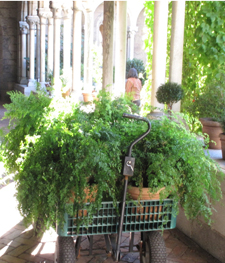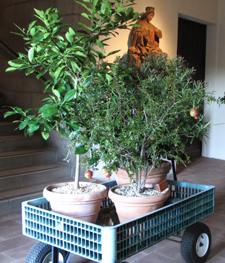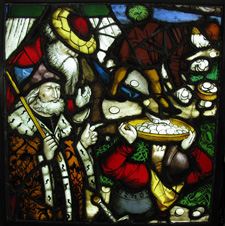Friday, October 28, 2011


Potted plants too tender to spend the winter in Bonnefont garden are trucked inside and brought up to Cuxa cloister, which is??glazed in mid-October. Mediterranean plants such as bitter orange, myrtle, and bay laurel spend the cold season in the sunny arcades and??are brought back out to the herb garden when the glass comes down in mid-April. Left:??A wagonload of maidenhair fern in the arcade of Bonnefont garden. Right:??oranges and pomegranates en route to Cuxa cloister.?? Photographs by Carly Still
While the medieval plant collection at The Cloisters includes a good number of northern European species, a great many of the plants grown in the Bonnefont Cloister herb garden are Mediterranean in origin. Not all of these southern European plants are hardy for us here in New York City. The garden is a sheltered U.S.D.A. Hardiness Zone 7, and the fig tree (Ficus carica), poet’s jasmine (Jasminum officinale), and lavender (Lavandula angustifolia) do just fine outdoors, but more tender species like bitter orange (Citrus aurantium), rosemary (Rosmarinus officinalis), bay laurel (Laurus nobilis), and dittany of Crete (Origanum dictamnus) must be brought inside and protected from the cold. Read more »
Tags: Albertus Magnus, bay, Citrus aurantium, cucumber, cucurbit, dittany, fern, ficus carica, fig, jasmine, Jasminum officinale, laurel, Laurus nobilis, Lavandula angustifolia, Lavender, maidenhair, myrtle, orange, Origanum dictamnus, rosemary, Rosmarinus officinalis, santolina, winter
Posted in Food and Beverage Plants, Fragrant Plants, Gardening at The Cloisters, Introduction, Magical Plants, Medicinal Plants, Medieval Agriculture, Plants in Medieval Art | Comments (2)
Friday, October 21, 2011

A tub of rose hips, gathered from roadsides and abandoned pastures upstate, and stripped of their thorns. The hips will be used to decorate the Museum this winter. Photograph by Carly Still
The rose hips used in the winter holiday decorations at The Cloisters allude to the rose symbolism prevalent in medieval Christmas carols. Although we grow medieval rose species in the gardens and on the grounds, their hips are too fleshy for our purposes, and don’t keep well.?? We gather stems of Rosa multiflora, which bear many small, hard, hips, in October, and strip them??of their thorns. They are stored in a cool, dry place until December, when the Museum is decked for the season.
Read more »
Tags: cattle, erosion, hips, Japanese rose, Rosa multiflora, rose, rose hip, weed
Posted in Food and Beverage Plants, Gardening at The Cloisters, Medicinal Plants, Useful Plants | Comments (1)
Wednesday, October 12, 2011


The marvelous food??depicted in these two panels of Late Gothic German stained glass may have been of vegetable origin. Left: Gathering Manna. Moses, holding the staff received from God on Mount Sinai, presides over the gathering of a miraculous fall of quail and manna from heaven. Right: Storing up Manna. Two men bear a large wooden tub of manna into a tent; a third man carries a great basketful in his arms.
The identification of Biblical plants has occupied investigators for centuries; the identity of manna is??one of??the most intriguing and most debated of ethnobotanical mysteries, although some interpreters have suggested that the substance is of insect rather than vegetable origin. Read more »
Tags: Albertus Magnus, algae, Avicenna, Bible, Circa Instans, Coccus manniparus, Exodus, Fraxinus ornus, Hortus Sanitatis, Lecanora esculenta, lichen, manna, Nostoc commune, Platearius, tamarisk, Tamarix mannifera
Posted in Food and Beverage Plants, Medicinal Plants, Plants in Medieval Art | Comments (1)





